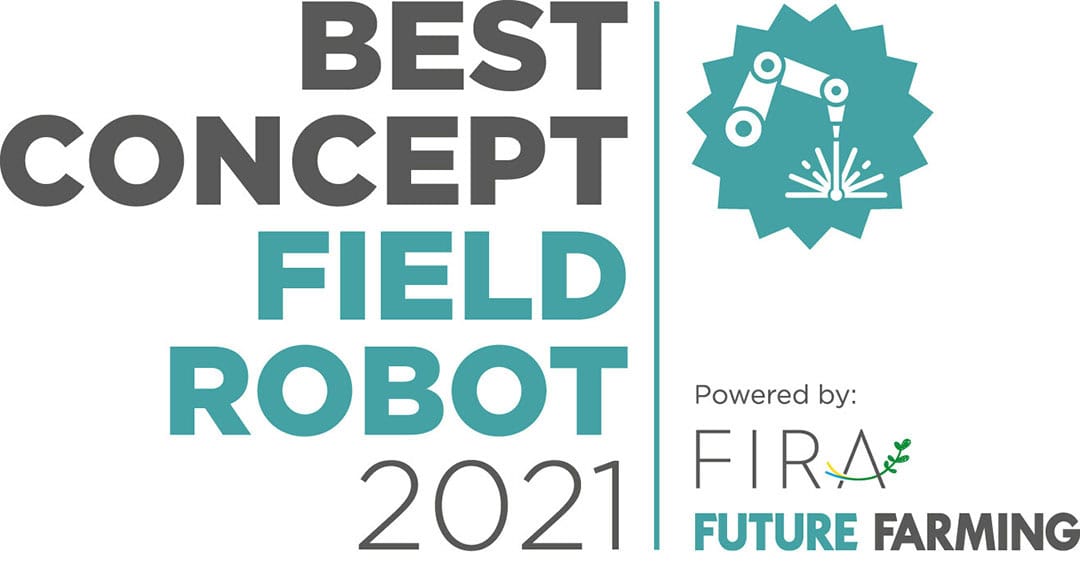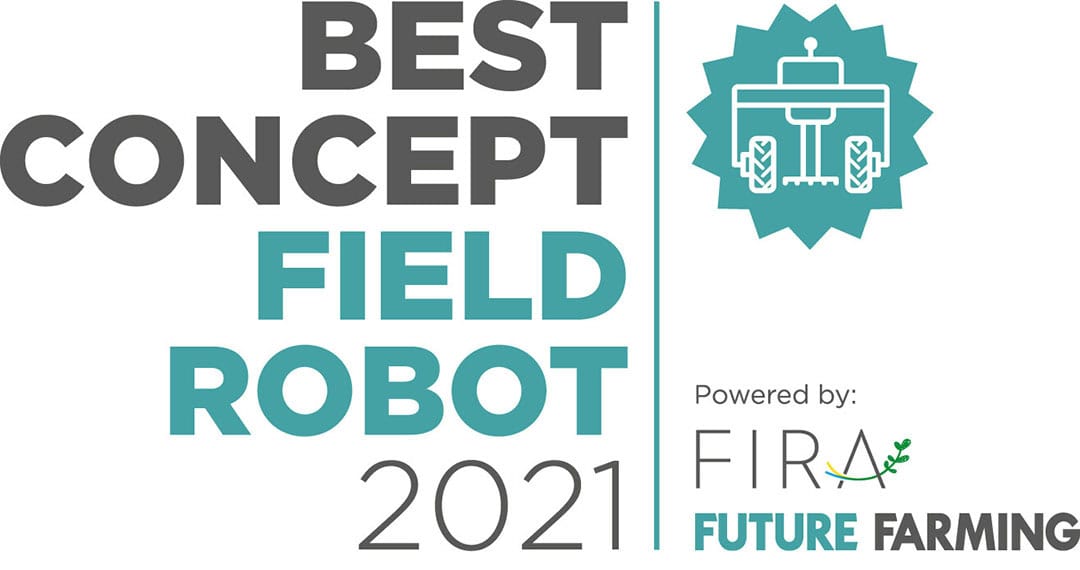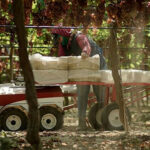10 robots compete for Best Field Robot Concept Award 2021

A common definition of a robot is an automatic machine that replaces human effort. Our review of the latest developments in the Best Field Robot Concept Award 2021 show that in agriculture they can do significantly more than that.
It wasn’t long ago that the idea of a machine that can negotiate its way around a field, up and down rows, along vines or in orchards really was a future ‘concept’.
Now, however, autonomous operation is just one of many technological advances included in the top ten Best Field Robot Concept Award entries we review here. It’s almost as if driverless operation is now the expected standard, it’s what else the robot can do that’s the interesting development.
Robots, which are actually at work today, provide agricultural and horticultural businesses with enormous advantages of significant technological advances. Many countries are now experiencing labour shortages at crisis levels, with crops left unpicked or untreated and lost profits, simply because there are not enough people to do the work. One machine can often do the work of ten people or more. Also, removing the human from the machine, increases safety and offers the ability to operate at the same standard without stopping.
Sensors not only steer the machine, but also monitor – providing the added benefit of precisely targeting treatments and inputs to exactly what an individual plant requires. At the same time they can collect and record huge amounts of data, which can be used to further cut costs, increase profits or attract premium prices.
Robots are also helping to reduce the impact on the environment and overcome resistance issues with precise mechanical weeders replacing or reducing the reliance on pesticides. Novel systems – spraying super heated oil, lasers and Ultra Violet light are also being used to control weeds, pests and diseases. At the same time the internal combustion engine is commonly replaced by electric or hybrid power systems.
In the Robot world advances are progressing at an unparalleled pace. Just as autonomous operation is now almost common, these innovative advances are likely to become the norm in the future.
Specialised robots

![]() Carbon Robotics’ Autonomous weeder robot tackles weeds with an innovative system using eight high-powered lasers. Developed by a young American start-up, which is just three years old, it’s designed for use in speciality cropping. Each of the weeding modules uses eight 150 W CO2 lasers that are ready to fire every 50 milliseconds hitting, the target with 3mm accuracy. It can operate day or night.
Carbon Robotics’ Autonomous weeder robot tackles weeds with an innovative system using eight high-powered lasers. Developed by a young American start-up, which is just three years old, it’s designed for use in speciality cropping. Each of the weeding modules uses eight 150 W CO2 lasers that are ready to fire every 50 milliseconds hitting, the target with 3mm accuracy. It can operate day or night.
Powered by a 74hp Cummins diesel engine, the Autonomous Weeder, is not only the weight and size of a mid-size tractor, it also costs about the same – although pricing details have yet to be disclosed.
![]() Tensorbot is another example of the latest generation of ‘new-tech’ laden weeding robots. It targets and kills weeds with micro-doses of superheated vegetable oil, replacing hand weeding without herbicides.
Tensorbot is another example of the latest generation of ‘new-tech’ laden weeding robots. It targets and kills weeds with micro-doses of superheated vegetable oil, replacing hand weeding without herbicides.
Developed by California, USA-based Tensorfield Agriculture, initial studies on large farms indicate 40% cost reductions compared with in hand weeding.
Built on a 3.3m wheelbase, the autonomous robot has a hybrid power system that comprises a 19kW Winco petrol engine generator supplying a LifePo4 battery. It has four independently steered wheels driven by individual motors.
![]() Vermeer, an American forage specialist, brings the latest automation and robotics to solving the age-old, time-consuming task of bale collection. At harvest there’s never time to do everything, so instead of leaving the bales in the field at risk of the weather, the ‘Bale Hawk’ goes and fetches them for you.
Vermeer, an American forage specialist, brings the latest automation and robotics to solving the age-old, time-consuming task of bale collection. At harvest there’s never time to do everything, so instead of leaving the bales in the field at risk of the weather, the ‘Bale Hawk’ goes and fetches them for you.
Powered by a diesel engine, running on tracks and with autonomous operation, it collects the bales and drops them off at the designated storage area. Interestingly, it detects the location of the bales using LiDAR sensors and cameras normally used for avoiding obstacles.
![]() Yanmar has developed its YV01 autonomous spray robot in conjunction with European vineyards. Weighing just 1t, it is specifically designed to reduce compaction, which is a big problem for vines.
Yanmar has developed its YV01 autonomous spray robot in conjunction with European vineyards. Weighing just 1t, it is specifically designed to reduce compaction, which is a big problem for vines.
It has a 200 litre capacity tank and an electrostatic spraying system, which electrically charges the droplets that are attracted to the neutral plants. This helps deliver full coverage to all the plants’ surfaces to boost efficacy and reduce chemical use.
Powered by a 27hp petrol engine, the robot is able to operate up and down hills up to 45% and across up to 19%.
Multipurpose robots

 Employing robots to carry out even the simplest tasks can bring big benefits. Future Acres, an American start-up, says its Carry autonomous harvest companion can boost production efficiency up to 30% in hand-picked crop operations.
Employing robots to carry out even the simplest tasks can bring big benefits. Future Acres, an American start-up, says its Carry autonomous harvest companion can boost production efficiency up to 30% in hand-picked crop operations.Using computer-vision-powered autonomy or through remote control operation, Carry uses machine learning and computer vision to avoid obstacles as well as collect and apply data to further enhance its precision.
It works autonomously, following farmworkers through the day. It is powered by replaceable battery with a 7–10hr charge time, enough for about a 6-10 miles traversed terrain navigation.
 Horsch is one of just a few mainstream farm machinery makers to reveal its thinking on autonomous field-scale operations. Although insisting the Roboter is purely a concept, it’s 400hp engine, Claas Twin-Trac drive and CVY transmission does indicate it’s interest lies in larger power units, akin to today’s tractors.
Horsch is one of just a few mainstream farm machinery makers to reveal its thinking on autonomous field-scale operations. Although insisting the Roboter is purely a concept, it’s 400hp engine, Claas Twin-Trac drive and CVY transmission does indicate it’s interest lies in larger power units, akin to today’s tractors.
Three factors are required for Autonomous operations, it says: first there’s a track planning system, which will need geo-fencing to constrain operations and probably the most important factor is safety. Horsch adds from a technical point of view it is working on different concepts – and currently doesn’t know which will stand the test of time.
 The Robotriks Traction Unit (RTU) proves advanced technology doesn’t necessarily mean complex and costly. Robotics graduate Khaian Marsh and Jake Shaw-Sutton, a senior robotics technician both from Plymouth University in the UK, have designed the low cost ‘farm assistant’ prototype robot using as many mass-produced components as possible.
The Robotriks Traction Unit (RTU) proves advanced technology doesn’t necessarily mean complex and costly. Robotics graduate Khaian Marsh and Jake Shaw-Sutton, a senior robotics technician both from Plymouth University in the UK, have designed the low cost ‘farm assistant’ prototype robot using as many mass-produced components as possible.
The RTU can be used as carrier, with manual remote control, to transport loads over difficult terrain. It can be operated under manual remote control, set up to repeatedly move between two points, sent to a location by tapping on a digital map or operate autonomously within fields, orchards and vineyards using an RTK guidance.
Harvesting robots

Two of the largest industrial corporations, Kubota and Yamaha, along with Impact Ventures, have invested $ 25 million in Advanced Farm Technologies (AFT), a USA-based start-up, which develops and manufactures a robotic strawberry harvester.
![]() The TX robotic strawberry harvester combines an unmanned ground vehicle with image sensors and artificial intelligence. Image recognition technology instantly distinguishes ripe and ready in-soil strawberries, which are each picked by grippers at the end of the robot arms. This automated technology significantly reduces conventional manned fruit and vegetable processes and maximises operational efficiency.
The TX robotic strawberry harvester combines an unmanned ground vehicle with image sensors and artificial intelligence. Image recognition technology instantly distinguishes ripe and ready in-soil strawberries, which are each picked by grippers at the end of the robot arms. This automated technology significantly reduces conventional manned fruit and vegetable processes and maximises operational efficiency.
![]() Muddy Machines, based in the UK, says while green asparagus is a relatively low volume crop, it is very suited to robot harvesting, which at the same time helps alleviate the severe labour shortage.
Muddy Machines, based in the UK, says while green asparagus is a relatively low volume crop, it is very suited to robot harvesting, which at the same time helps alleviate the severe labour shortage.
Called ‘Sprout’ the fully autonomous machine uses AI to identify and selectively harvest the asparagus spears to the grower’s specifications using a unique, patent-pending gripper device. It avoids immature spears, works in weeds and navigates tight clusters without damaging the crop.
After picking it automatically moves along the row. At the same time its on-board computer and AI system collects data on emerging spears, helping growers to predict future yields.
![]() Ripe Robotics, an Australian company, is testing its third generation automated fruit harvester, called Eve, which it hopes will go on sale after further improvements. It can currently pick both apples and oranges.
Ripe Robotics, an Australian company, is testing its third generation automated fruit harvester, called Eve, which it hopes will go on sale after further improvements. It can currently pick both apples and oranges.
Electric drive propels the robot along a row of fruit trees, using its on-board camera system, with the data is processed through a deep neural network, to identify ripe fruit. Currently a person monitoring to the system, intervenes if the Eve can’t decide on the ripeness. This also helps it to learn. Suction tubes harvest the fruit and transport it to the holding bin.
Join 17,000+ subscribers
Subscribe to our newsletter to stay updated about all the need-to-know content in the agricultural sector, two times a week.



